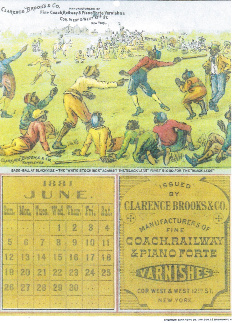Many variables determine price. They include:
- Condition. A better conditioned card is obviously more valuable than a damaged card.
- Rarity (or lack thereof). For example, ordinary H 804-7 Gargling Oil Liniment cards are quite common and therefore deserving lower prices.
- Color (as opposed to black and white). Although most trade cards are multicolored and to many collectors attractive, a few collectors desire black and white images due to their scarcity.
- Real players. Some trade cards have the names of real, often famous, players. Cards in the H 804-21 set are an outstanding example.
- Unique categories. Collectors of categories such as "blacks" (H 804-5), "pixies" (H 804-2) and early or late publishing (H 804-6) tend to affect the price of these cards.
- Demand (or lack thereof). Negatively, many collectors, for a variety of reasons, simply do not want certain cards. For example, sets H 804-14, H 804-32, and H 804-34 are just not attractive to some collectors.
It was difficult to place a price on these baseball advertising trade cards in the original 1980 booklet since there was not extreme interest or resultant transactions between collectors and/or dealers. Collecting trade cards in general has now become a more popular hobby and the "baseball" category itself is one of the more desirable trade cards. Demand is much greater, so prices are higher than in 1980. But how "high?"
Regular auctions, especially "on line," of trade cards now occur. Some winning bids are extremely high. Many dealers then place extremely high values on all trade cards regardless of scarcity or condition. H 804-7 Gargling Oil trade cards are not rare yet some are priced by dealers in the $30-40 range!
These auctions have recently led to the inflation, often extreme, of trade card values. But is an "auction price" necessarily the future "market price" of an item? Not necessarily. One bidder, for whatever reason, can outrageously outbid competition. Example: An item that usually sold in the $30-40 range is entered in an auction. Eight collectors bid in the $20-55 range. Ten collectors bid in the $60-100 range but two collectors bid over $200. Is a final winning bid of $235 the new "market price" and should $235 be published in a price guide book? Dealers exultantly hope so. Collectors wonder — and gulp! What happens if the same card goes at a much lower bid in two other auctions?
Auction prices should be considered in determining a guide price. However, while auction prices reflect a trend, one winning bid, whether ridiculously high or even ridiculously low, should not establish a "market price." But, too frequently, it does.
With that in mind, the second edition in 1997 on page 83 gave each set and each individual card a "guide" letter indicating an approximate dollar value. At that time, some dealers said these prices were too low while many collectors said the prices were too high. Nevertheless, I no longer know what is an accurate market (or even "reasonable") price. Therefore, here in this third edition (2010), no attempt is made to price these cards.
These baseball advertising trade cards are not that easy to find in Excellent condition. Many cards in my own personal collection are in only Poor, Good or Very Good condition. I would advise collectors of the more difficult trade cards to take any condition and then, with luck, to upgrade the condition.
NOTE WELL: Baseball card collectors, some of whom now seek baseball trade cards, should be aware that trade card collectors often use a DIFFERENT condition grading system than that used by baseball card collectors.
| Baseball Card Grading Classifications | Trade Card Grading Classifications |
|---|---|
| MINT | EXCELLENT |
| EXCELLENT | VERY FINE |
| VERY GOOD | FINE |
| GOOD | VERY GOOD |
| FAIR | GOOD |
| POOR | POOR |
This illustration is NOT a trade card since it appears as part of a calendar. It has appeared in auctions as a trade card — after the original calendar section had been cut off!
